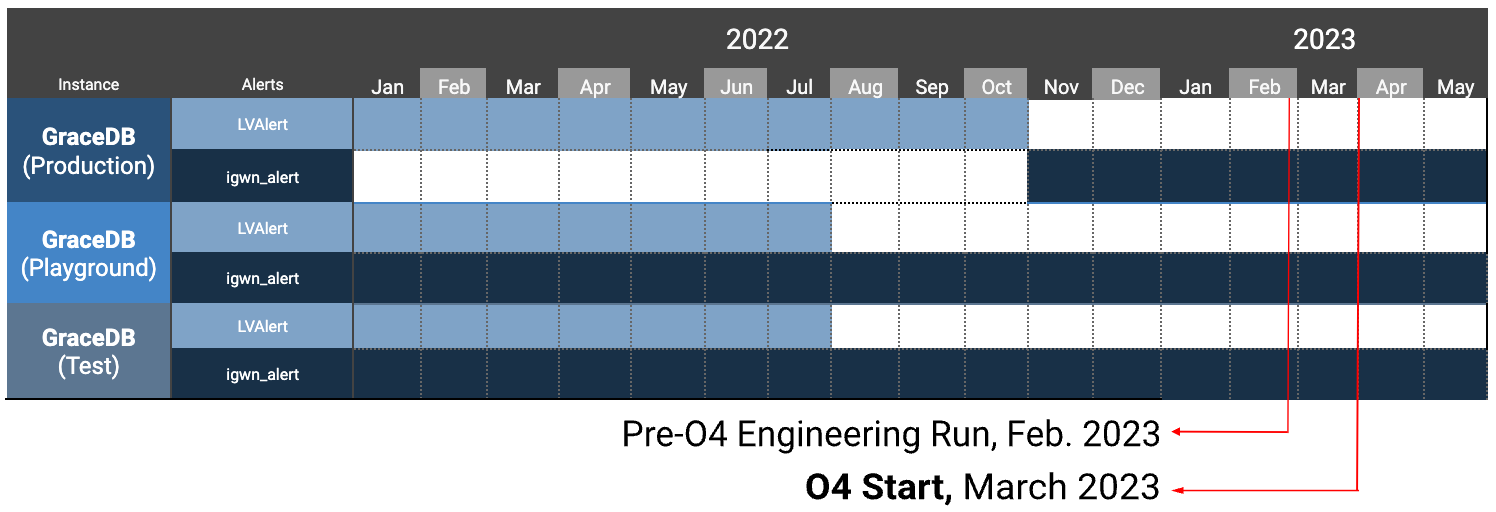LVAlert to igwn-alert Transition
This page will be updated as need be ahead of O4.
This page is intended as a brief guide to assist users in adjusting their workflows from LVAlert to the new igwn-alert system.
Rollout Schedule
The legacy LVAlert XMPP notification service will be decommissioned before O4.
Before then, gracedb-test.ligo.org and gracedb-playground.ligo.org have been
configured to simultaneously send LVAlerts and igwn-alerts. The message content and
scenarios (new events/superevents, new log messages, etc.) are the same. This is to
allow users to test their existing workflows using LVALert and igwn-alert while
participating in the MDC campaigns on gracedb-playground. Please see the
schedule below.

To emphasize:
igwn-alerts are currently being sent on the playground and test servers, and will continue to leaving up to O4.
The first pre-O4 Engineering Run is nominally scheduled for mid-February 2023
The production
gracedb.ligo.orgserver will publish igwn-alerts starting in November 2022.On this date, the legacy LVAlert servers will be decommissioned and users will no longer be able to run their LVAlert workflows.
What’s the Same
With some exceptions (to be described below), the workflow for users of
ligo-lvalert’s Python API should be largely the same. The listen
method takes in a callback function argument and (optionally) a topic or list of topics, and will
launch the callback function when a new alert arrives to one of the provided topics.
Optionally, like the ligo-lvalert tool, a user can receive alerts from the command line. For example, assuming the user’s subscriptions/permissions are set, the following commands are equivalent:
lvalert -s lvalert-playground.cgca.uwm.edu listen
igwn-alert -g gracedb-playground listen
What’s Different
While LVAlert and igwn-alert are both Publish-Subscribe (pubsub) tools, there are differences between the two tools. These differences are largely semantic and should become more more clear by comparing the following table:
LVAlert |
igwn-alert |
|
|---|---|---|
Servers |
There are multiple LVAlert servers. Each one corresponds to an instance of GraceDB (production, playground, test). |
There is a single SCIMMA server to handle each instance of GraceDB. Users make a single account, and then finer-grained control is handled by account credentials. |
Accounts |
A user makes an account on each of the LVAlert servers. The username is tied to their LVK account, and has a customizable password. |
A user makes a credential after gaining access to SCIMMA’s server. The username is tied to their LVK username (plus a random hex string), and the password is assigned at credential creation. A user can optionally create multiple credentials to selectively control what processes receive what alerts. |
Alerts are sent to |
Nodes |
Topics |
Alerts are controlled by |
Subscriptions. A user subscribes to a node. Alerts will arrive only to nodes for which the user has a subscription. |
Permissions. Assigning a “read” permission to a topic is analogous to adding a subscription to a node. Further on permissions: as was described earlier, users only have read permission to GraceDB topics. |
Listening to GraceDB instances |
A separate LVAlert server is available for each GraceDB instance.
The node names (like |
There is a single server, but different groups for each instance of
GraceDB. The topic list is identical across groups, and topic names take
the form |
Controlling subscriptions/ permissions |
Subscriptions were added or removed using the |
Permissions are added to a credential manually using SCIMMA’s web-based interface. Note: the process of adding credentials and permissions should only have to be done once. |
Showing nodes/topics |
Available nodes were listed using the |
Available topics are shown for all permitted groups in the SCIMMA web
interface. Once a permission is added for a topic, then it is listed with
the |
Also removed from igwn-alert are the stand-alone Python2 executables
(lvalert_listen, lvalert_send, lvalert_admin). As such, the use of .ini files to
launch external processes is no longer supported. Users are encouraged to take advantage
of the new Python3 API.